Development of domestic breeders for the Russian climate - “Valentina” tomato
Tomato Valentina is known to many gardeners in all regions of our country. And this is not surprising, because it was bred specifically for the Russian climate, which is often completely unpredictable. Frequent alternations between cool days and heavy rains or, conversely, severe drought are not scary for the variety - the tomato will withstand any weather test. But its main feature is its vitamin composition. The fruits are rich in vitamins C, K and B, proteins, fiber, organic acids, carotene and minerals.
Characteristics and description of the variety
The Valentina tomato variety was bred more than two decades ago by Russian breeders. Included in the State Register of Selection Achievements in 1998. Ideal for breeding in any climatic conditions of Russian regions, both in open and protected ground.
Distinctive features
Determinant type, non-standard, spreading, height 55-60 cm. Branching is weak, leaves are yellow-green. The inflorescences are simple, the first one is formed above the 6-7th leaf, the next ones every 1-2 leaves.
Reference! The main difference between a non-standard plant and a standard one is the weak stem.
An early ripening species, 95-100 days pass from the emergence of seedlings to full ripening.
The yield is high, 3-4 kg are harvested from 1 seedling, provided that 6-7 plants are planted per 1 square meter. m. Fruiting is not extended, ripening occurs at the same time.
It is highly resistant to the main diseases of the nightshade family. Well adapted to short droughts.
The culture does not require pinching, but it is impossible to do without a garter, despite the short stature of the seedlings. The fruiting branches are strewn with ripe vegetables, so they cannot bear the weight of them.
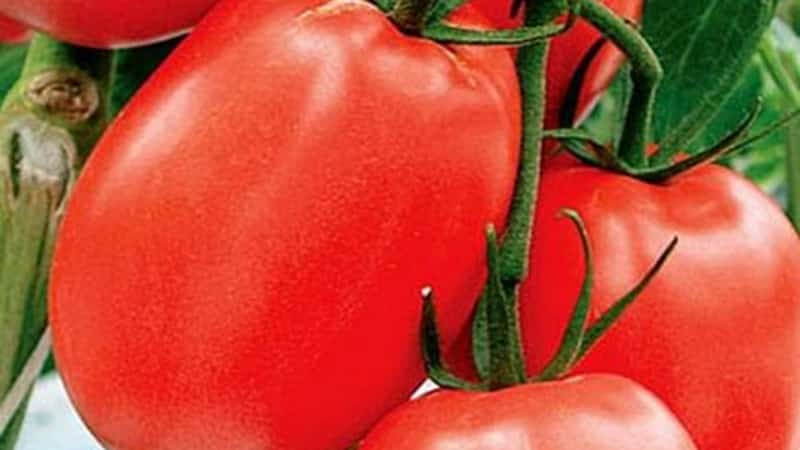
Fruit characteristics
Average weight 80-90 g, oval shape, elongated, orange-red, rich color. The taste is sweet with a slight sourness, the flesh is juicy and meaty. There are 2 seed chambers, few seeds. The skin is thick, durable, and not prone to cracking.
The purpose of tomatoes is universal: they are used fresh for preparing a variety of dishes, used for winter preparations and processed into tomato products.
Ripe vegetables can be stored for several months and can withstand long-term transportation without losing their presentation.
The photo shows Valentina tomatoes.
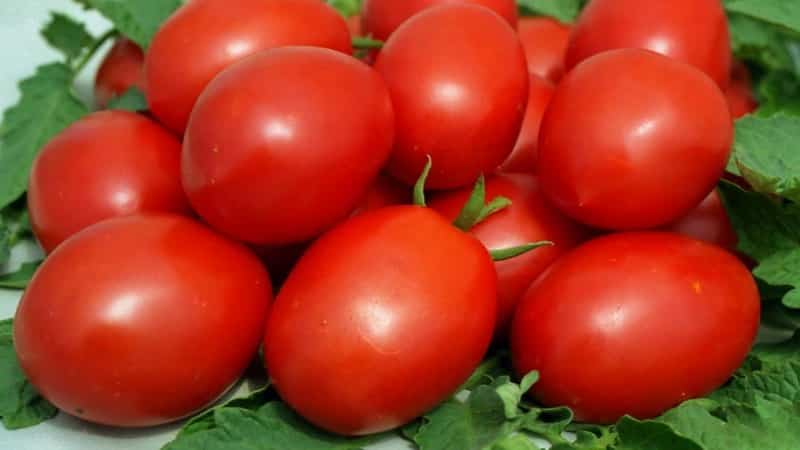
How to grow seedlings
Sowing seeds for seedlings begins 2 months before planting in the ground. Seed material must be prepared for planting in order to prevent a number of diseases and increase the quantitative indicator of fruiting.
Seed preparation
The grains are laid out on the table and carefully examined one by one for visible damage. Grains suitable for sowing must be light in color, without bends or defects. They are then placed in a saline solution for 10 minutes. Those seeds that have sunk to the bottom are washed with running water and disinfected in a weak solution of potassium permanganate for 20 minutes.
To improve germination, seeds are soaked in a growth stimulator for 10 hours. Swollen grains can be sown in the ground.
Reference! In addition to specialized drugs, melt or ordinary boiled water can serve as a growth stimulator.
Container and soil
The soil is prepared from a mixture of garden soil, humus, peat and river sand. River sand is added as a leavening agent for lightness.. Peat contains many useful substances necessary for the full growth and development of seedlings. Such nutritious and fertile soil will accelerate the emergence of seedlings.
The resulting mixture is disinfected by steaming in an oven at a temperature of 50°C for at least 15 minutes or spilled with a hot solution of manganese. Soil disinfection destroys pathogenic flora, which ensures healthy growth of seedlings throughout the entire period.
You can plant in a common wooden box or in a separate container. Fill the planting container halfway with the prepared soil, adding the remaining soil as the seedlings grow. This technique helps to constantly receive the required amount of nutrients. Small drainage holes are made in advance at the bottom of the containers to allow excess moisture to drain into them.
Sowing
Seeds are sown to a depth of 1.5-2 cm with a distance of 3 cm from each other. Cover with soil on top, level, compact and lightly moisten with warm, settled water using a spray bottle. The sown containers are covered with film, thereby creating a greenhouse effect and left in a dark and warm room at a temperature of 24-26°C until germination.
Growing and care
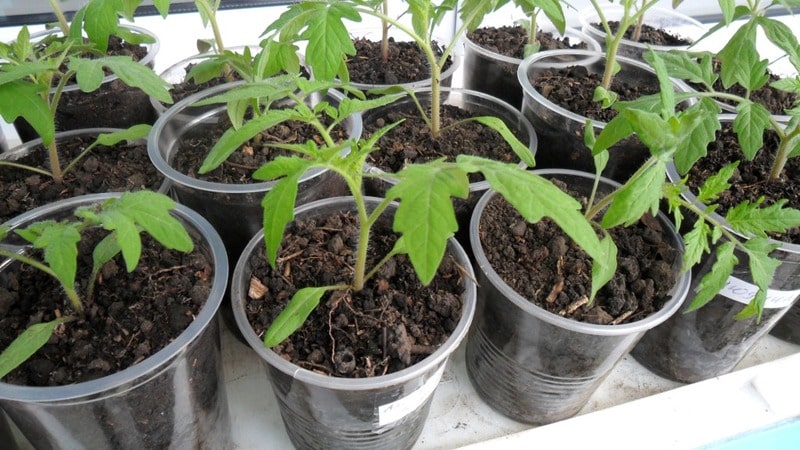
When shoots appear, the film is removed and the containers are moved to a well-lit place on the windowsill. The temperature is maintained at 24-25°C. Daylight hours for seedlings are at least 14 hours. If the plants do not have enough daylight, they are illuminated with phytolamps.
Water moderately along the edge of the nursery with warm, settled water using a regular tablespoon. The main thing is not to overwater the sprouts, as excess moisture will negatively affect the young roots. After watering, the soil is loosened superficially with a wooden stick.
When 2 true leaves appear, the seedlings dive and are planted in separate containers. If the seeds are sown in peat pots, the seedlings do not need picking. The picking procedure involves shortening the main root by one third. Picking promotes the growth of lateral roots, due to which the seedlings grow vigorously.
Reference! Throughout the entire period, seedlings do not need feeding.
2-2.5 weeks before planting, the seedlings are hardened off by taking them outside for 1 hour at a temperature of 16°C. Gradually, the time spent outdoors is increased to 14 hours. Simultaneously with daytime hardening, the night temperature in the room is reduced to 12°C.
How to grow tomatoes
After 2 months, the seedlings are ready for planting in the ground. By this time, it has 5-7 true leaves, a strong stem and a fully developed root system.
Landing
The soil is prepared in the fall, dug up and fertilized with humus. In the spring they dig again with the addition of mineral fertilizers. For planting, prepare holes 15-20 cm deep at the bottom of which a little sawdust or wood ash is placed.
Replant on a cloudy day or in the evening, after sunset. The tomato is planted in the ground in which beets, herbs, garlic, cabbage or carrots previously grew. After these crops, the soil is not depleted, which is favorable for crops from the nightshade family.
Planting pattern: 40 cm – distance between seedlings, 60 cm – row spacing. For 1 sq. m place 6 – 7 plants.They are planted in a checkerboard pattern, which helps to ventilate each plant and receive the required amount of light. After transplantation, the bushes are not watered or fed for 2 weeks. During this time they adapt to new conditions.
Further care for the Valentina tomato
Regular watering installed no more than 2 times a week. Water with warm water, using 4-5 liters for each bush. During the formation of buds, the amount of watering is increased, watering every 3 days. After each watering, the beds are loosened, removing weeds and thereby destroying a favorable substrate for the development of fungal diseases.
Also, pests successfully multiply in weeds, which, moving to tomatoes, destroy both the leaves and the fruits themselves. To keep the beds moist longer, they are mulched with peat or straw.
Feed tomatoes once every 3 weeks. Before flowering feeding Mineral fertilizers are used, containing mainly nitrogen, which is necessary for the active growth of shoots. Organics are also used, for example, urea solution.
During the formation of the ovaries, they are fed with potassium-phosphorus fertilizers for faster fruit filling. 35 g of superphosphate and potassium salts are dissolved in 10 liters of water.
Reference! All fertilizing is applied after watering, at the root of the plants.
Features of care and possible difficulties
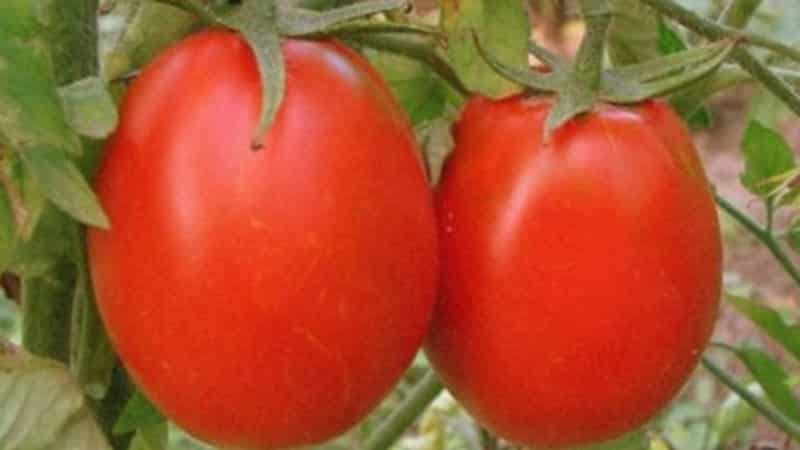
Culture does not require stepsons. Moreover, experienced gardeners claim that pinching this variety leads to a decrease in yield.
Bushes need mandatory garter not only the stem, but also the fruit-bearing branches. To do this, wooden stakes or metal rods are installed next to each seedling, to which the plants are fixed.If the stem is tied to a support immediately after transplantation, the trunk will form smooth and strong. As the branches develop, they must also be fixed, otherwise they will creep along the ground from the weight of ripe vegetables. In addition, tied branches make harvesting easier.
Diseases and pests
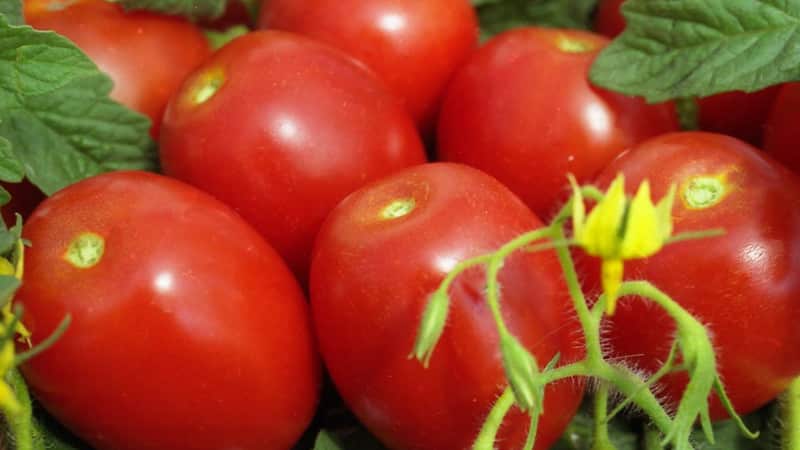
The most dangerous fungal diseases for tomatoes are: late blight, gray rot and fusarium leaf wilt. The risk of disease increases with prolonged rains and constant humidity in the beds due to non-compliance with a moderate watering regime.
For preventive purposes, plants are treated with contact fungicides “Fitosporin” and “Hom”. You can also spray plants with infusions of various herbs, for example: nettle, plantain, onion peel decoction.
Treating plants with such infusions protects the crop from many pests that do not like strong odors. These include: whitefly, spider mite, mole cricket. To scare away the mole cricket that lives underground, crushed cloves of garlic are dug into the beds.
The surest preventative method is to inspect the bushes for pests and changes. In this way, pathology can be prevented almost immediately, which will preserve the health of the plants.
The nuances of breeding in open ground and in a greenhouse
Tomato leaves have a yellow-green color, but this does not mean that the plant is unhealthy. This color is quite normal for this variety and does not imply any health measures.
Pinching shoots leads to a decrease in the quantitative indicator of fruiting; it is not recommended to pick off leaves even during the seedling period.The only leaves to be removed are the lowest ones, as if they come into contact with wet beds they can rot and cause various infections.
When transplanting into open ground in regions with a temperate climate, do not forget about the danger of an unexpected drop in temperature. For such cases, keep covering material on hand so that, if necessary, you can use it immediately, thereby preserving the plants. The crop is also covered in case of prolonged rains.
Closed structures are ventilated daily. The influx of fresh air destroys the usual habitat of pathogenic microorganisms and many pests. In addition, ventilation regulates the humidity level, preventing it from rising and creating favorable conditions for the development of diseases.
Harvesting and application
Ripe vegetables begin to be collected in July-August. Fruiting is not extended, ripening is almost simultaneous, which significantly simplifies harvesting.
The purpose is universal: smaller tomatoes are used for whole-fruit canning, barrel pickling and marinades. Larger vegetables are processed into tomato products, from which excellent juices, pastes, adjika, ketchups and lecho are obtained.
Tomatoes are also ideal in any fresh dishes: summer salads, hot and vegetable stews, purees, they are used in a variety of snacks and sandwiches. Also used in baking with meat and for pizza.
Ripe vegetables are stored for several weeks and even months without loss of memory and can withstand long-term transportation, perfectly maintaining their presentation.
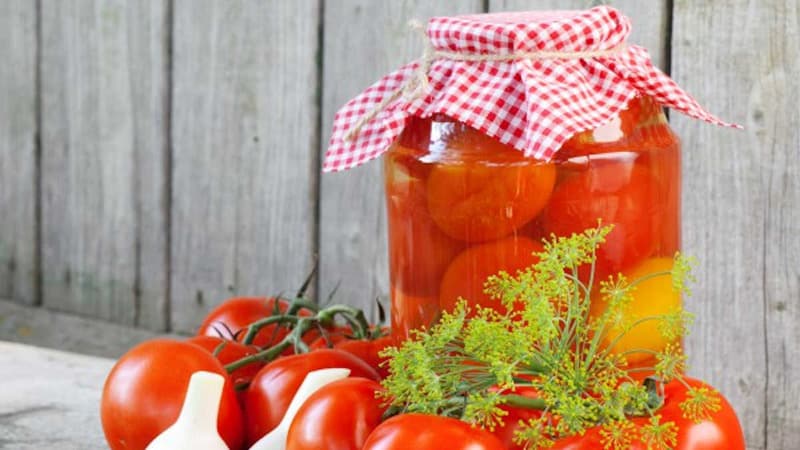
Advantages and disadvantages
The overview of this section will summarize all the positive properties of the culture and note some of the disadvantages. The benefits include:
- drought resistance;
- early ripening;
- friendly return:
- unpretentious care;
- does not require pinching;
- high fruiting rate;
- possibility of breeding in any region;
- immunity to diseases;
- excellent taste of fruits;
- universal purpose;
- long storage;
- long transportations.
The disadvantages include the mandatory staking of short plants, but this is a common procedure with which all gardeners are familiar.
Farmer reviews
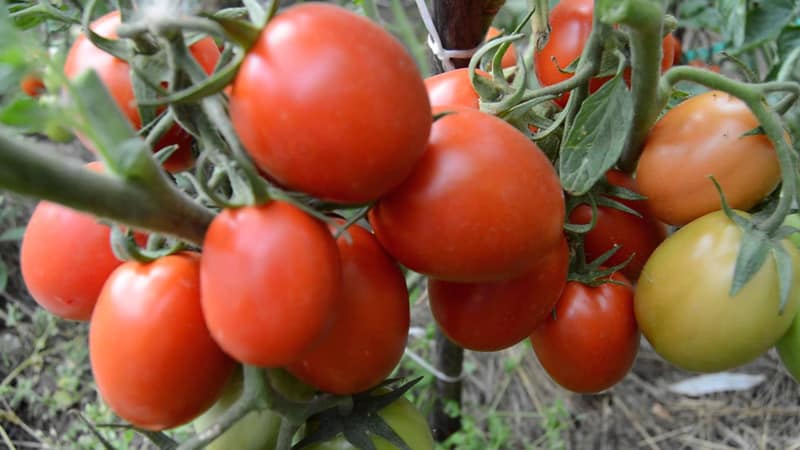
Judging by the characteristics and reviews of those who planted the crop in their gardens, for most gardeners this tomato is a kind of lifesaver that will not fail under any circumstances.
Vera, Magnitogorsk: “I was very impressed by the photos, so I decided to plant this tomato. The seeds sprouted quickly and the seedlings were not sick. Grown in open ground. Even with minimal care, the variety pleased with its yield. Each bush ripened 6-7 fruits. I used it for pickling, but they are also good fresh. I’ll definitely plant it again.”
Peter, Nizhny Novgorod: “Great view for open ground. I always plant low-growing tomatoes in a garden bed without shelter. The bushes do not stretch and produce good offspring. Vegetables of unusual elongated shape. The pulp is juicy. The taste is pleasant, you can add these tomatoes to salads. The variety is also suitable for preservation. I didn’t overshoot the plants, the yield was at the same level.”
Conclusion
When creating the Valentina tomato, Russian breeders tried to instill in it a unique adaptation to unfavorable climatic conditions. Thanks to this, the variety is resistant to drought and cold snaps.The formation of ovaries in any weather is a definite plus in regions that do not have a constant temperature regime. The high rate of fruiting, disease resistance, simple agricultural technology and the versatility of the fruits attract more and more new fans of the variety every year.